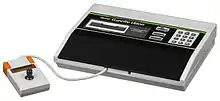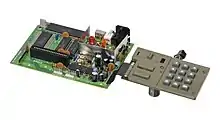 A Super Cassette Vision and its accompanying paddle–based game controller | |
| Manufacturer | Epoch Co. |
|---|---|
| Type | Home video game console |
| Generation | Third generation |
| Release date |
|
| Introductory price | ¥14,800 |
| Units sold | c. 300,000[1] |
| Media | ROM cartridge |
| CPU | 8-bit NEC µPD7801G |
| Memory | 128 bytes RAM, 4kB VRAM |
| Display | 309×246 resolution, 16 colors, 128 on-screen sprites |
| Graphics | EPOCH TV-1 |
| Sound | µPD1771C @ 6 MHz |
| Predecessor | Cassette Vision |
The Super Cassette Vision (Japanese: スーパーカセットビジョン, Hepburn: Suupaa Kasetto Bijon) is a home video game console made by Epoch Co. and released in Japan on July 17, 1984, and in Europe, specifically France, later in 1984. A successor to the Cassette Vision, it competed with Nintendo's Family Computer and Sega's SG-1000 line in Japan.
History
Epoch's original Cassette Vision was introduced in Japan by Epoch in 1981, which had steady sales and took over 70% of the Japanese home console market at the time, with around 400,000 units sold.[2] However, the introduction of next-generation systems from Nintendo, Casio and Sega quickly pushed back the original Cassette Vision, leading Epoch to quickly develop a successor. The Super Cassette Vision was released in 1984 at a cost of ¥14,800 yen,[3] featuring an 8-bit processor and better performance more in line with its competitors. It was later released in France by ITMC under the Yeno branding.[4] At least 16 games were brought over from Japan for a European release.[5] A version of the system targeted the young female market, the Super Lady Cassette Vision. The console came packed in a pink carrying case, alongside the game Milky Princess.[6] The system did not take off, and was unable to match the massive popularity of the Nintendo Famicom, leading Epoch to drop out of the console market by 1987.
Technical specifications

- CPU: 8-bit NEC µPD7801G microcontroller[7] @ 4 Mhz
- RAM: 128 bytes (internal to CPU)
- ROM: 4 KB (internal to CPU)
- Video processor: EPOCH TV-1 @ 14 Mhz
- VRAM: 4 KB (2 × µPD4016C-2) + 2 KB (EPOCH TV-1 internal)
- Colors: 16
- Sprites: 128
- Display: 309×246
- Sound processor: µPD1771C @ 6 MHz
- Sound: 1 channel (tone, noise or 1-bit PCM)
- Controllers: 2 × hard-wired joysticks
Games
- 1. Astro Wars - Invaders from Space
- 2. Astro Wars II - Battle in Galaxy
- 3. Super Golf
- 4. Super Mahjong
- 5. Super Base Ball
- Giants Hara Tatsunori no Super Base Ball
- 6. Punch Boy
- 7. Elevator Fight
- 8. Lupin III
- 9. Nebula
- 10. Wheelie Racer
- 11. Boulder Dash
- 12. Miner 2049er
- 13. Super Soccer
- 14. Comic Circus
- 15. Milky Princess
- 16. Pop and Chips
- 17. Nekketsu Kung-Fu Road
- 18. Star Speeder
- 19 TonTon Ball
- 20. Super Sansu-Puter
- 21. Shogi Nyuumon
- 22. Doraemon
- 23. BASIC Nyuumon (included four basic games)
- 24. Dragon Slayer
- 25. Rantou Pro-Wrestling
- 26. WaiWai(Y2) Monster Land
- 27. Dragon Ball: The Great Unexplored Dragon Region
- 28. Mappy
- 29. Sky Kid
- 30. Pole Position II
Unreleased games
- Black Hole
- Super Derby
- Super Rugby
External links
References
- ↑ "pc.watch.impress.co.jp" (in Japanese). 2018. Retrieved October 7, 2020.
- ↑ "株式会社 エポツク杜 堀江正幸氏 (pg. 9)" (in Japanese). 1998. Retrieved August 29, 2017.
- ↑ "Hardware Heaven: Super Cassette Vision". Retro Gamer (233): 32–33. June 2022. Retrieved 21 May 2022.
- ↑ "Ma collection YENO & EPOCH Super Cassette Vision" (in French). Retrieved August 29, 2017.
- ↑ Shiver (2004). "YENO Super Cassette Vision" (in French). Internet Services. Retrieved August 29, 2017.
- ↑ "Epoch Super Cassette Vision: Models & Clones". Video Game Console Library. Retrieved August 29, 2017.
- ↑ "Epoch Super Cassette Vision: Specs & Manuals". Video Game Console Library. Retrieved August 29, 2017.